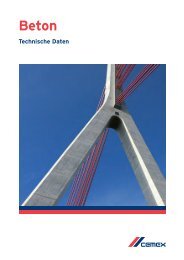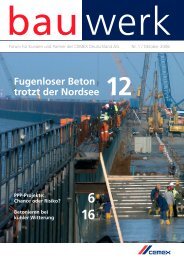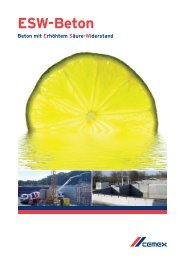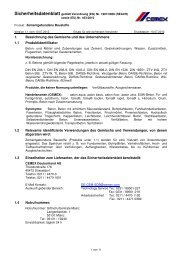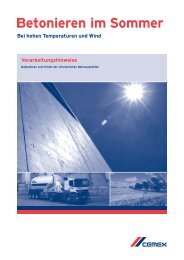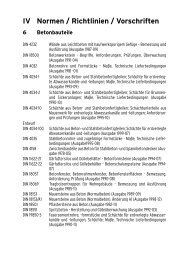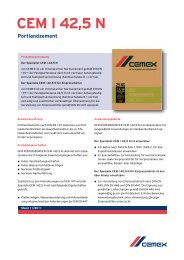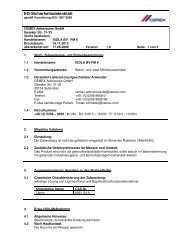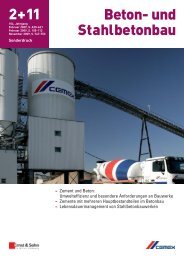building a better future - Cemex
building a better future - Cemex
building a better future - Cemex
Create successful ePaper yourself
Turn your PDF publications into a flip-book with our unique Google optimized e-Paper software.
WE HAVE BEEN<br />
SUCCESSFUL IN<br />
DEVELOPING PROJECTS<br />
THAT GENERATE<br />
CERTIFIED EMISSION<br />
REDUCTIONS<br />
collaborating to determine industry key performance<br />
indicators and best practices<br />
In the year 2000, the World Business Council for Sustainable<br />
Development (WBCSD) convened a group of leading cement<br />
companies and related stakeholders to identify key challenges<br />
facing the industry. One of the most critical challenges identified<br />
was the industry’s CO2 emissions, and the development of<br />
long-term actions to address them. The result of this collaboration<br />
was the formation of the WBCSD Cement Sustainability<br />
Initiative (CSI) and its Agenda for Action, published in 2002.<br />
Since then, the CSI has focused on the proactive management<br />
and communication of issues ranging from CO2 emissions and<br />
responsible fuel usage to sustainability reporting and socialimpact<br />
monitoring.<br />
As a founding member of the CSI, CEMEX has committed to<br />
monitoring and reporting greenhouse gas emissions from all<br />
its cement plants, in accordance with the CSI Cement CO2 and<br />
Energy Protocol. In 2011, the CSI released the third edition of<br />
the Protocol, introducing.<br />
• New KPIs<br />
• Updated definitions around biomass fuel content<br />
• More thorough accounting standards for on-site power<br />
generation<br />
• Greater compatibility with international carbon accounting<br />
and reporting guidelines<br />
compensation for reducing emissions<br />
CEMEX stays closely abreast of international discussions and<br />
policy developments addressing climate change and is supportive<br />
of environmental regulations that are fair and well<br />
designed. Within our key markets, a number of market-based<br />
mechanisms for emissions reduction have been established,<br />
and we are well positioned to take advantage of these opportunities.<br />
The European Union Emissions Trading System (EU<br />
ETS) and the Clean Development Mechanism (CDM) are both<br />
important platforms for emissions trading that allow us to pursue<br />
a variety of carbon-reduction projects more economically.<br />
Thus far, we have been particularly successful in developing<br />
projects that generate Certified Emission Reductions (CERs).<br />
Issued under the CDM, a provision of the Kyoto Protocol for<br />
emissions-reduction projects in developing countries, CERs<br />
can be sold on the open market or used to offset emissions.<br />
Structured in this fashion, the CDM plays an important role in<br />
supporting the sustainable development of nations with less<br />
stringent environmental regulations, by rewarding projects<br />
that go above and beyond basic efforts to manage direct emissions.<br />
CEMEX has registered eight projects under the CDM—<br />
including four additions in 2011—for a total carbon offset<br />
potential of 1.4 million tons per year. And with more than ten<br />
CDM projects in the pipeline, as well as two additional initiatives<br />
currently in validation process under the Verified Carbon<br />
Standard (VCS), CEMEX expects to make significant additional<br />
reductions to its carbon footprint in the coming years while<br />
producing valuable CO2 credits.<br />
The CSI regularly publishes aggregate data on energy<br />
consumption and CO2 emissions in our sector; for more<br />
information visit the online database or download the<br />
report “Getting the Numbers Right” at www.wbcsdcement.<br />
org/pdf/CSI%20GNR%20Report%20final_updated%20<br />
Nov11_LR.pdf<br />
Additional resources<br />
> CEMEX Position Paper on Market<br />
Mechanisms for Mitigating Climate<br />
Change<br />
> Clean Development Mechanism<br />
> IEA Cement Technology Roadmap 2009<br />
> Verified Carbon Standard<br />
> WBCSD Cement Sustainability Initiative<br />
> CSI Getting the Numbers Right:<br />
· Database<br />
· Report<br />
PROJECT YEAR CERs/YEAR<br />
EURUS Wind Farm 2007 599,571<br />
Costa Rica Alternative Fuels 2008 42,040<br />
Colombia Alternative Fuels 2008 169,565<br />
Zapotiltic Alternative Fuels 2010 47,043<br />
Egypt Alternative Fuels 2011 416,528<br />
Panama Alternative Fuels Kiln 1 2011 29,212<br />
Tepeaca Alternative Fuels 2011 103,359<br />
Merida Alternative Fuels 2011 41,513<br />
Reduction Potential (tCO2/year) 2011 1,448,831<br />
Assiut Cement Plant in Egypt<br />
increasing the use of alternative fuels<br />
< previous 23 next>



